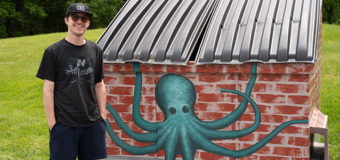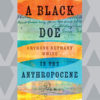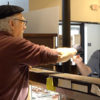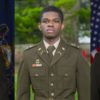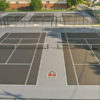ESU Honors Student Project Links Past and Present
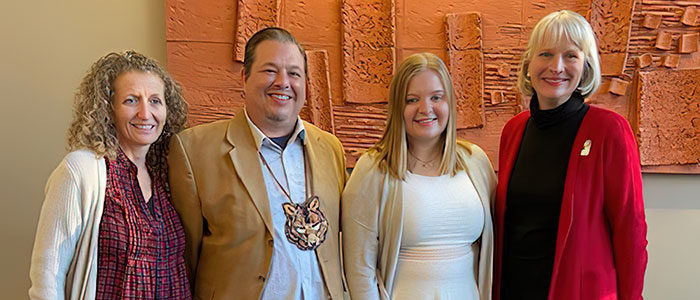
Posted by: Elizabeth Richardson on November 19, 2021, No Comments
An East Stroudsburg University honors program student is using modern technology to educate others about an ancient culture in a new exhibit.
Emily Serpico, a senior history and communication double major who is also pursuing a business writing certificate, utilized 3D technology to replicate several artifacts from Greene Dreher Historical Society for her honors thesis project, currently on display in Stroud Hall. The exhibit, Living Legacies: Community Connections, is the result of several months of work in which Serpico teamed up with Susan Bachor, Delaware Tribe Historic Preservation Office and ESU instructor of history and geography; Darlene Farris-LaBar, ESU professor and chair of art + design; and students such as art + design major, James Holloway, by lending various areas of expertise, including 3D scanning and 3D printing.
The exhibit allowed Serpico to apply her various skill sets and take a hands-on approach to her studies. She honed her cataloguing and researching skills during her internship with Bachor last summer, and she currently works at the Schisler Museum of Wildlife and Natural History and McMunn Planetarium. Her supervisor at the museum, Cathy Klingler, did some consulting work on the project. “It came together pretty naturally,” Serpico said.
The exhibit timeline was aggressive, according to Bachor: “The initial brainchild happened in the spring. We wanted to have what Emily was already doing incorporated into her thesis so it wasn’t overwhelming. She ended up designing this project and exhibit. It took about 8-9 months, which is a short time for an exhibit. That’s a very demanding timeline that Emily held to. November is Indigenous People’s Month and we had the Assistant Chief visit us on campus, and this helped us stick to the timeline.”
Serpico’s exhibit includes replicated projectile points, a Delaware blanket, buckskin pelts, a map, and a collection of minerals. Many of the items were gathered by Anna Hazleton London, a local historian from the Tafton, Pa. area, and came to Serpico and her team by way of the Greene-Dreher Historical Society in South Sterling, Pa. “We are telling a story about community connections,” Serpico said. “We are looking at the Delaware Tribe of Indians and so many things about them. We have a map of the homeland. The flintknapping process—that’s where we were able to have the oversized 3D artifact. One of the cases contains many items from the Greene-Dreher Historical Society. It’s been great to work with these items that were handled by the historical society. Connections between the tribe and the university were wonderful, too.” The exhibit is tied together by a timeline that provides a narrative and context to the artifacts and their relevance to life in the tribe.
Bachor said the exhibit provides an important link between ESU and the Delaware Tribe of Indians: “Part of the agreement ESU has with the tribe is the university offers us office space and access to the university’s technology. In return, we offer extra educational programming that isn’t offered at the university. ESU doesn’t have museum studies classes. The art + design department and I are the closest things to that. We have an obligation to fulfill.” Bachor said the exhibit also provides an important service of simply educating the campus community about the Lenape people, especially as the descendants of these indigenous people are still alive. “Getting them the proper recognition that they once held this land, it was theirs, and taken from them in horrific ways. We’re now 250 years away from that. Freshmen coming into ESU don’t realize the historical connection with the Lenape. This land was taken from the Lenape by the Walking Purchase. Even back then, it was fought in courts. This exhibit brings history to students etc. passively.”
The exhibit is a full circle look at technology. Many of the items on display were state-of-the-art at the time, and early versions of today’s technology. “The tools we’re handling—people can say they’re primitive, but they were high tech at the time. These people were incredibly creative. Because of them, we have what we have today. That technology provided us with what we have today—that’s what’s fascinating. ESU has an incredible art + design 3D program for this emerging technology. It’s a way to bring these things to life. Here I am, with these objects on the 3D scanner, and there’s a real connection through time in that moment. It was beautiful,” Farris-LaBar said.
The exhibit was the perfect opportunity to utilize ESU’s 3D technology capabilities. “We [Farris-LaBar and Bachor] had talked about ways we could replicate some Lenape artifacts with the technology we have,” Farris-LaBar said. “We had strong interest [in] making this happen, then Emily came along and Susan introduced us, and we started talking. We have a great team here. I like to incorporate students in our 3D design space here. It’s this type of opportunity and these projects that expand the perspectives to my students also. That’s what all of this is about.”
The exhibit has been a great learning experience for everyone involved. “Just getting the experience has been wonderful, and reassuring in the way. In the museum field, you need a lot of experience to get the kind of job I’d like. This kind of experience makes me feel more assured and has given me a look into my future,” Serpico said. “I feel pretty confident the art + design students involved would say the same, along with Tyler Prutzman (ESU student) who helped us do the website. Tyler is thrilled to have this in his portfolio. It’s been a collaborative effort at every level.”
Bachor is hoping to build on Serpico’s project. She and Farris-LaBar have applied for a grant for funding will allow them to expand the project to include additional items, improved signage, and other enhancements. The exhibit had a soft opening on November 8. ESU administrators and other notable guests attended, including Jeremy Johnson, assistant chief of the Delaware Tribe of Indians, and Anna Hazleton-London’s grandchildren.
Living Legacies: Community Connections is on display in Stroud Hall’s atrium lobby.
